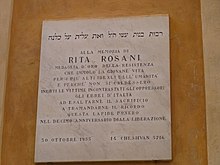Rita Rosani
Rita Rosani ( November 20, 1920 in Trieste - September 17, 1944 in Monte Comun, Grezzana ) was an Italian teacher and resistance fighter against Nazi fascism. She was one of the most famous Jewish partisans .
Life
Rita Rosani's father, Ludwig Rosenzweig, came from Moravia and moved to Fiume and later to Trieste in 1905 because of the increasingly anti-Semitic mood in his home country . In the Austro-Hungarian port city on the Adriatic , he changed his name to Ludovico Rosani and married Rosa Strakosch, who was also from Moravia. In 1920 their daughter Rita was born in Trieste.
Rita Rosani grew up in fascist Italy and attended the fascist youth facilities after school. Her childhood and youth were relatively carefree. Her friends included Umberto Saba's daughter and her later fiancé Giacomo "Kubi" Nagler, whose family came from Galicia .
In September 1938 the situation for the Jewish population in the Kingdom of Italy worsened with the gradual promulgation of the Italian race laws . As a result, Rita Rosani was expelled from the public school and was forced to complete her teacher training at a school established by the Jewish community. After completing her education, she taught in a Jewish elementary school in her home town. After DELASEM was founded in 1939, she also worked for this charity for Jewish emigrants.
Even before the Italian entry into the war on June 15, 1940, Rita Rosani and Kubi Nagler married. Since her fiancé lost his Polish citizenship due to the war, he was interned as a stateless Jew after the Italian entry into the war and ended up with his parents in the Italian concentration camp Casoli in the Abruzzo region . Even if they had been in correspondence for a while, the relationship ended up breaking up. It is uncertain whether Rita Rosani learned that her former fiancé and his parents were deported to Auschwitz in January 1944 .
After the announcement of the Italian armistice with the Allies on September 8, 1943, the situation for the Jewish population in Trieste came to a head. The armistice resulted in the German occupation of Italy . Trieste was incorporated into the Adriatic Coastal Operation Zone and was under direct German administration. In September 1943, the Germans began to arrest and deport the Jewish population in the operational zone. The news of the persecution that reached them led Rita Rosani to join the Resistancea . Before that, she brought her parents to safety in the countryside, where they stayed until the end of the war and survived the Holocaust .
Rita Rosani was initially active underground in Portogruaro . She then joined a partisan group in the province of Verona and transmitted messages to various resistance cells. The group led by Umberto Ricca, an officer of the Italian General Staff who did not join the armed forces of the Italian Social Republic after September 8 and instead went into the armed resistance, was hiding in a small hut on Monte Comune in the foothills of the Lessinian Alps east of Valpolicella and north of Verona .
The group of around 15, named Banda armata dell'Aquila , carried out acts of sabotage in Valpolicella and in the area around Zevio in the Adige Valley . On September 17, 1944, the hiding place of the group was discovered during a raid by the Guardia Nazionale Repubblicana , supported by units of the Wehrmacht , on Monte Comun northeast of Grezzana. In the firefight that followed, Rita Rosani was wounded and, after she surrendered, was shot in the head by the GNR commander, Lieutenant Mario Scaroni .
In 1945, Scaroni was sentenced in the first instance to a prison term of 20 years, which he never had to serve due to an amnesty.
Award
- Gold Medal of Bravery , awarded posthumously
Commemoration
- In Rome , Trieste and Verona streets were named after her.
- Two schools in Verona also bear her name, a primary school in Borgo Trento and a secondary school in Borgo Venezia.
- Two memorial stones commemorate the resistance fighter, one at the Jewish school in Trieste, where she taught, and one at the synagogue in Verona , where - in Hebrew - a verse from the Bible was engraved:
"Many women have shown themselves to be brave, but you surpass them all."
- A memorial stone was placed on the site of her murder. Every year a commemoration is held there, organized by the Volontari della Libertà in collaboration with the municipalities of Negrar and Grezzana.
literature
- Livio Isaak Sirovich: Non era una donna, what un bandito. Rita Rosani, una ragazza in guerra. Cierre Edizioni, Verona 2014, ISBN 978-88-8314-765-4 .
Web links
- Rosani, Rita (1920-1944) , short biography on memorial sites Europe 1939-1945
Individual evidence
- ↑ a b c d e Cecilia Cohen Hemsi Nice: Ritratti. Rita Rosani. In: it.pearson.com. Retrieved April 11, 2020 (Italian).
- ↑ Nagler, Giacomo. In: cdec .it. Retrieved April 11, 2020 (Italian).
- ↑ a b Donne e uomini della Resistenza: Rita Rosani. In: anpi .it. July 25, 2010, accessed April 11, 2020 (Italian).
| personal data | |
|---|---|
| SURNAME | Rosani, Rita |
| BRIEF DESCRIPTION | Italian teacher and resistance fighter |
| DATE OF BIRTH | November 20, 1920 |
| PLACE OF BIRTH | Trieste |
| DATE OF DEATH | September 17, 1944 |
| Place of death | Grezzana |
